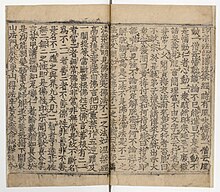
Back বেদিসূত্র Bengali/Bangla Tribunová sútra Czech Sūtra de l’Estrade French 六祖壇経 Japanese 육조단경 Korean Plattformsutraen NB Sutra Szóstego Patriarchy Huinenga Polish Сутра помоста шестого патриарха Russian สูตรของเว่ยหล่าง Thai Platform Sutra Turkish

The Platform Sutra of the Sixth Patriarch (Chinese: 六祖壇經; pinyin: Liùzǔ Tánjīng or simply: 壇經 Tánjīng) is a Chan Buddhist scripture that was composed in China during the 8th to 13th century.[1] The "platform" (施法壇) refers to the podium on which a Buddhist teacher speaks. Its key themes are the direct perception of one's original nature,[2] and the unity in essence of śīla (conduct), dhyāna (meditation) and prajñā (wisdom).
The text centers on the teachings and stories ascribed to the sixth Chan patriarch Huineng. It contains the well-known story of the contest for the succession of Hongren (enlightenment by the non-abiding), and discourses and dialogues attributed to Huineng.
The text attributes its recollection to Fa-hai, but was probably written, or redacted, within the so-called Oxhead school, which existed along with the East Mountain School and Shenhui's Southern School. The text attempts to reconcile the so-called Northern School with its alleged gradual enlightenment teachings, and the so-called Southern School with its alleged sudden enlightenment teachings. In effect, the text incorporates the "rhetorical purity" which originated with Shenhui's attack on Shenxiu, while effectively "writing him out of the story".[3]
- ^ Schlütter 2007, p. 385.
- ^ The Sixth Patriarch's Dharma Jewel Platform Sutra. Buddhist Text Translation Society. 2014. ISBN 9781601030696.
- ^ McRae 2003, p. 60-69.